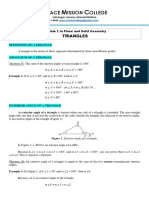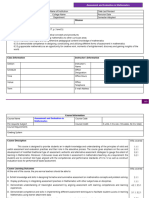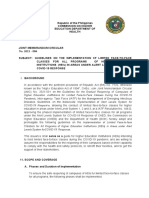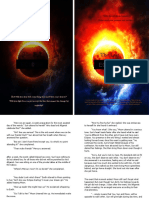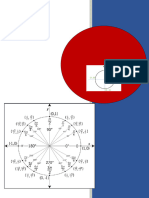Module 1 Modern Geometry
Uploaded by
Miguel PAlmaresModule 1 Modern Geometry
Uploaded by
Miguel PAlmaresPASSI CITY COLLEGE
City of Passi. Iloilo
M a t h 1 0 7 : Modern Geometry (Euclidean and Non-Euclidean Geometry)
Definition and
History of Geometry
Miguel L. Palmares III
October, 2020
PASSI CITY COLLEGE
City of Passi. Iloilo
College Vision:
Passi City College- a Center Of Academic Excellence for Sustainable Development and Social
Transformation.
Mission:
Passi City College is committed to produce globally competent graduates who are well
equipped with relevant scientific, academic, and technological knowledge, skills and values which
enable them to become productive citizens and collaborators of social change.
Goals:
1. Provide undergraduate education and training which meet the standard of quality, excellence,
and responsible to regional, national, and international development needs.
2. Broaden the access of deserving and qualified Filipinos to higher opportunities.
3. Enhance the dissemination of knowledge and skill through research, professional and
technological instruction and provide extensive services.
BACHELOR OF SCIENCE IN SECONDARY EDUCATION (MATHEMATICS)
Program Outcomes:
Graduates of the BSED Major in Mathematics degree program is expected to:
a. Exhibit competence in mathematical concepts and procedures
b. Exhibit proficiency in relating mathematics to other curricular areas
c. Manifest meaningful and comprehensive pedagogical content knowledge (PCK) of mathematics
d. Demonstrate competence in designing, constructing, and utilizing different forms of assessment
in mathematics
e. Demonstrate proficiency in problem-solving by creating routine and non-routine problems with
different levels of complexity
f. Use effectively appropriate approaches, methods, and techniques in teaching mathematics
including technological tools
g. Appreciate mathematics as an opportunity for creative work, moments of discovery, and
gaining insights of the world
Miguel L. Palmares III Page 2
Math 114- Modern Geometry Module 1
Welcome to Modern Geometry!
Passi City College adopted Blended Learning in response to the restrictions brought by the pandemic to
travel and physical interaction. We will be using modular mode of learning, supplemented by virtual
classrooms, in delivering our topics. This module will serve as the main learning material for this semester.
You are expected to complete the tasks included in this module to pass the subject.
You are expected to complete the tasks included in this module to pass the subject. You will be graded
based on the assessment tasks included in the module and the major exam at the end of the semester.
Further instructions will be given in our messenger chat rooms.
Enjoy the course! 😊
Miguel L. Palmares III, MILE
Instructor
Course Description
This course introduces the students to historical evolution of geometrical concepts and Euclidean
geometry. It also includes the discussion of geometries- Euclidean, NonEuclidean, and finite- with emphasis on
the appropriate postulates and postulational method
During and at the end of the semester, a graduate student must have:
1. used varied experiences that enforce and extend logical reasoning skills to constructing proofs,
including direct and indirect proofs, to mathematical assertions;
2. developed an understanding of an axiomatic system through investigating and comparing various
geometries;
3. identified described, compared, and classified geometric figures and represented problem situations
with geometric models;
4. showed appreciation of geometry as means of describing the physical world by taking notice of things
seen everyday
Miguel L. Palmares III Page 3
Math 114- Modern Geometry Module 1
Module 1
Overview
In this module, you will learn the history and definitions of geometry. We will discuss Euclid’s axioms
and postulates, as well as Playfair’s parallel postulate.
Learning Objectives
At the end of this module, the students should have:
learned the history and definitions of Modern Geometry
familiarized the early geometers
learned Euclid’s axioms and postulates
learned Playfair’s parallel postulate
proved geometry statements using axioms and postulates
Course Content: Introduction to Advance Statistics
1. Definition and History of Geometry
2. Early Geometers
3. Euclidean Geometry as a Deductive Science
4. Some Flaws in Euclid’s Assumption
Negation of Parallel Postulate
Activity Description Time to Complete
1. Discuss brief history and definition of geometry 15 minutes
2. Introduce early geometers 15 minutes
3. Explain geometry as a deductive science 15 minutes
4. Discuss Euclid’s axioms and postulates 30 minutes
5. Discuss flaws of Euclid’s assumptions 30 minutes
6. Solve Euclid’s fifth postulate using Plafair’s postulate 40 minutes
7. Assessment 35 minutes
Deadline of the module is on : Monday, October 16, 2020 at 11:59pm
Definition and History of Geometry
Miguel L. Palmares III Page 4
Math 114- Modern Geometry Module 1
Egyptians’ geometry (study of properties and relations of figures with themselves and with each
other; used geometric facts for surveying and construction; but no evidence that they could generalize these
facts to some theorems OR even make a proof for this.
Greek Geometry (used proofs; many new ideas were discovered; thus these need to be
consolidated/need tying together/synthesized)
Please watch this video:
Geometry - Basic Definitions - Part 1 | Origin of Geometry | Don't Memorise
https://www.youtube.com/watch?v=CrIdJKo0whs
Try it Now 1
1. Explain how geometry is used in ancient civilizations and how it is used today.
Early Geometers
Pythagoras
Pythagoras, one of the most famous and controversial
ancient Greek philosophers, lived from ca. 570 to ca. 490
BCE. He discovered that a complete system of
mathematics could be constructed, where geometric
elements corresponded with numbers, and where integers
and their ratios were all that was necessary to establish an
entire system of logic and truth.
Miguel L. Palmares III Page 5
Math 114- Modern Geometry Module 1
Archimedes
Archimedes proved, among many other geometrical results, that
the volume of a sphere is two-thirds the volume of a
circumscribed cylinder. This he considered his most significant
accomplishments, requesting that a representation of
a cylinder circumscribing
Plato a sphere be inscribed on his tomb.
Euclid
He organized logically the facts and created “The Elements”
around 300 B.C. The Elements is one of the most influential books in
mathematics and, with the exception of the Bible, the most widely
studied book in history.
He was a teacher of mathematics in Alexandria and the founder of
the Alexandrian School of Mathematics. He is the teacher of
Pythagoras
Euclidean Geometry as a Deductive Science
From few basic assumptions, and few definitions, He proceeded to prove more than 400 theorems,
separated in 13 books. The ELEMENTS was used as a model for “Deductive Reasoning”
Axioms
1. Things which are equal to the same thing are also equal to one another.
2. If equals be added to equals, the wholes are equal.
3. If equals be subtracted from equals, the remainders are equal.
4. Things which coincide with one another are equal to one another.
5. The whole is greater than the part.
Miguel L. Palmares III Page 6
Math 114- Modern Geometry Module 1
Please watch this video.
Euclid's Geometry - Axioms - Part 1 | Don't Memorise
https://www.youtube.com/watch?v=K6R4MHB2wlM
Postulates of Euclid (From J. Smart)
1. A straight line can be drawn joining any two points.
2. A finite straight line can be produced continuously in a straight line.
3. A circle may be described with any point as center and any distance as a radius.
4. All right angles are equal to one another.
Please watch this video!
Euclid’s First Four Postulates | Euclid's Postulates | Don't Memorise
https://www.youtube.com/results?search_query=Euclid%27s+Geometry+-+Axioms+-+Part+1+%7C+Don
%27t+Memorise
Miguel L. Palmares III Page 7
Math 114- Modern Geometry Module 1
Some Definitions of Euclid
• A point is that which has no part.
• A straight line is a line which lies evenly with the points on itself.
• When a straight line set up on a straight line makes the adjacent angles equal to one another, each
of the equal angles is right, and the straight line standing on the other is called perpendicular in
which it stands.
Postulates
• 5. If a transversal falls on two lines in such a way that the interior angles on one side of the
transversal are less than two right angles, then the lines meet on that side on which the angles are less than
two right angles.
The fifth postulate is equivalent to what is known as the parallel postulate.
Parallel Postulate
(Playfair’s Version)
• Through a point not on the line, there exist a unique line parallel to the given line.
Please watch this video!
Euclid's 5th Axiom and Playfair's Axiom
https://www.youtube.com/watch?v=qBI-RyA0loc
Try it Now 1
Miguel L. Palmares III Page 8
Math 114- Modern Geometry Module 1
Explain briefly how Playfair’s axiom proved Euclid’s 5 th axiom.
Some Flaws in Euclid’s Assumption
Need a definite statement about the
• continuity of lines and circles
• infinity of a line
• Order of points on the line
• Uniqueness of a line containing two points
• Fact that when a line enters the triangle at the vertex, then it intersects the opposite sides
Many tried to correct the flaws and attempted to improve the ELEMENTS paving the way for the Birth of Non-
Euclidean Geometries (grew out of the attempt to prove the 5th postulate).
Hyperbolic Geometry
Hyperbolic geometry is the geometry you
get by assuming all the postulates of Euclid,
except the fifth one, which is replaced by
its negation.
Elliptic Geometry
Elliptic geometry is a non-Euclidean
geometry with positive curvature which
replaces the parallel postulate with the
statement "through any point in the plane,
there exist no lines parallel to a given line."
Negation of Parallel Postulate
Miguel L. Palmares III Page 9
Math 114- Modern Geometry Module 1
Through a point not on the line, there exists more than one line parallel to the given line. (Hyperbolic
Geometry Postulate)
Through a point not on the line, there exists no line parallel to the given line. (Elliptic
Geometry Postulate)
Summary of Topics
Definition and History of Geometry
Early Geometers
Euclidean Geometry as a Deductive Science
Some Flaws in Euclid’s Assumption
Negation of Parallel Postulate
Assessment Tasks
1. The beauty of Geometry is also seen in Art. Many works of renowned artists like Leonard da Vinci and
M.C. Escher showed mesmerizing geographical patterns. Show your artistic side and create your own
geometric design.
2. Explain mathematically or create your own illustration of the following Axioms
1. Things which are equal to the same thing are also equal to one another.
2. If equals be added to equals, the wholes are equal.
3. If equals be subtracted from equals, the remainders are equal.
4. Things which coincide with one another are equal to one another.
5. The whole is greater than the part.
“The best way to predict your future is to create it.”
-Abraham Lincoln
Miguel L. Palmares III Page 10
Math 114- Modern Geometry Module 1
Miguel L. Palmares III Page 11
Math 114- Modern Geometry Module 1
You might also like
- Problem Solving, Mathematical Investigation and Modeling: Learning Guide83% (6)Problem Solving, Mathematical Investigation and Modeling: Learning Guide28 pages
- Problem Solving, Mathematical Investigations and Modelling50% (2)Problem Solving, Mathematical Investigations and Modelling8 pages
- Problem Solving, Mathematics Investigation and Modelling Course Syllabus86% (7)Problem Solving, Mathematics Investigation and Modelling Course Syllabus4 pages
- Module Principles Strategies in Teaching MathNo ratings yetModule Principles Strategies in Teaching Math274 pages
- Principles and Strategies in Teaching Mathematics100% (4)Principles and Strategies in Teaching Mathematics12 pages
- Articulate K To 12 Competencies in Mathematics Learning With Success Indicators (Enabling Skills)100% (1)Articulate K To 12 Competencies in Mathematics Learning With Success Indicators (Enabling Skills)29 pages
- MTH 1110 Logic and Set Theory Abrd Basic Mathematics Bist Yr1 Sem1100% (1)MTH 1110 Logic and Set Theory Abrd Basic Mathematics Bist Yr1 Sem163 pages
- Coaching Notes Friday November 10 2017 Lecture Notes in Mathematics PDFNo ratings yetCoaching Notes Friday November 10 2017 Lecture Notes in Mathematics PDF22 pages
- Syllabus Math Ed 15 Principles and Methods of Teaching100% (1)Syllabus Math Ed 15 Principles and Methods of Teaching9 pages
- 01 - Set of Axioms and Finite Geometries (Part 3)100% (2)01 - Set of Axioms and Finite Geometries (Part 3)21 pages
- Im Module 5 Finite Geometries of Fano and Young Pappus and DesarguesNo ratings yetIm Module 5 Finite Geometries of Fano and Young Pappus and Desargues38 pages
- TTL2 (Instrumentation and Technology in Mathematics)100% (1)TTL2 (Instrumentation and Technology in Mathematics)9 pages
- Lecture 4 Postulational Basis For Projective GeoemetryNo ratings yetLecture 4 Postulational Basis For Projective Geoemetry4 pages
- Problem-Solving, Mathematical Investigation and Modelling: MATH 110100% (2)Problem-Solving, Mathematical Investigation and Modelling: MATH 11035 pages
- Problem Solving, Mathematical Investigation and Modeling Week 2 Strategies For Solving Problems100% (1)Problem Solving, Mathematical Investigation and Modeling Week 2 Strategies For Solving Problems5 pages
- Ed Math 6 Calculus 1 With Analytic Geometry100% (1)Ed Math 6 Calculus 1 With Analytic Geometry2 pages
- Authentic Assessment Methods in Mathematics Education100% (2)Authentic Assessment Methods in Mathematics Education37 pages
- MATH 69: Assessment and Evaluation in MathematicsNo ratings yetMATH 69: Assessment and Evaluation in Mathematics29 pages
- Principles and Strategies in Teaching Math For StudentsNo ratings yetPrinciples and Strategies in Teaching Math For Students78 pages
- Elementary Stat Course Syllabus S.Y 2020-2021No ratings yetElementary Stat Course Syllabus S.Y 2020-202113 pages
- Module 5 Neutral Geometry Projective Geometry and Differential GeometryNo ratings yetModule 5 Neutral Geometry Projective Geometry and Differential Geometry12 pages
- Assessment and Evaluation in Mathematics Prelim100% (3)Assessment and Evaluation in Mathematics Prelim19 pages
- Assessment and Evaluation in Mathematics Syllabus100% (1)Assessment and Evaluation in Mathematics Syllabus10 pages
- Prelim Examination in History of Mathematics100% (2)Prelim Examination in History of Mathematics4 pages
- Prelim Examination in History of MathematicsNo ratings yetPrelim Examination in History of Mathematics4 pages
- Dawal, A. Bsed Math-3a (Assignment 1) - 081624No ratings yetDawal, A. Bsed Math-3a (Assignment 1) - 0816244 pages
- Addressing the Digital Divide in AustraliaNo ratings yetAddressing the Digital Divide in Australia6 pages
- Passi City College Passi City, Iloilo School of Teacher Education Module in National Service Training Program I (CWTS I)100% (1)Passi City College Passi City, Iloilo School of Teacher Education Module in National Service Training Program I (CWTS I)4 pages
- GE 102 Purposive Communication: School of Teacher EducationNo ratings yetGE 102 Purposive Communication: School of Teacher Education5 pages
- National Service Training Program 1 Vivian G. PadernalNo ratings yetNational Service Training Program 1 Vivian G. Padernal3 pages
- Module 1 Action Research in MathematicsNo ratings yetModule 1 Action Research in Mathematics16 pages
- The Last The Last: "Love Doesn't Mean Happiness, It Also Need Your Patience and SacrificesNo ratings yetThe Last The Last: "Love Doesn't Mean Happiness, It Also Need Your Patience and Sacrifices4 pages
- Section 4.3 Riemann Sums and Definite IntegralsNo ratings yetSection 4.3 Riemann Sums and Definite Integrals38 pages
- (Free) 2017 A Level Specimen Paper With SolutionsNo ratings yet(Free) 2017 A Level Specimen Paper With Solutions28 pages
- Material_Science_DPP_04_English_6669cf42802d9b001868f4c8No ratings yetMaterial_Science_DPP_04_English_6669cf42802d9b001868f4c83 pages
- JEE Mains 2023 Shift 1 Question Paper 11 Apr With Solutions PDFNo ratings yetJEE Mains 2023 Shift 1 Question Paper 11 Apr With Solutions PDF28 pages
- 2025 Langley's Adventitious Angles - WikipediaNo ratings yet2025 Langley's Adventitious Angles - Wikipedia3 pages
- Lovely Professional University: DeclarationNo ratings yetLovely Professional University: Declaration5 pages
- Year 9 Revision - Forming and Solving EquationsNo ratings yetYear 9 Revision - Forming and Solving Equations63 pages
- Etale Cohomology of Rigid Analytic Varieties and Adic Spaces PDFNo ratings yetEtale Cohomology of Rigid Analytic Varieties and Adic Spaces PDF2 pages
- Elements Map Projection: Chart ConstructionNo ratings yetElements Map Projection: Chart Construction208 pages
- Pre Calculus Q4 Week 1 2 Angles in A Unit CircleNo ratings yetPre Calculus Q4 Week 1 2 Angles in A Unit Circle24 pages
- Problem Solving, Mathematical Investigation and Modeling: Learning GuideProblem Solving, Mathematical Investigation and Modeling: Learning Guide
- Problem Solving, Mathematical Investigations and ModellingProblem Solving, Mathematical Investigations and Modelling
- Problem Solving, Mathematics Investigation and Modelling Course SyllabusProblem Solving, Mathematics Investigation and Modelling Course Syllabus
- Articulate K To 12 Competencies in Mathematics Learning With Success Indicators (Enabling Skills)Articulate K To 12 Competencies in Mathematics Learning With Success Indicators (Enabling Skills)
- MTH 1110 Logic and Set Theory Abrd Basic Mathematics Bist Yr1 Sem1MTH 1110 Logic and Set Theory Abrd Basic Mathematics Bist Yr1 Sem1
- Coaching Notes Friday November 10 2017 Lecture Notes in Mathematics PDFCoaching Notes Friday November 10 2017 Lecture Notes in Mathematics PDF
- Syllabus Math Ed 15 Principles and Methods of TeachingSyllabus Math Ed 15 Principles and Methods of Teaching
- Im Module 5 Finite Geometries of Fano and Young Pappus and DesarguesIm Module 5 Finite Geometries of Fano and Young Pappus and Desargues
- TTL2 (Instrumentation and Technology in Mathematics)TTL2 (Instrumentation and Technology in Mathematics)
- Lecture 4 Postulational Basis For Projective GeoemetryLecture 4 Postulational Basis For Projective Geoemetry
- Problem-Solving, Mathematical Investigation and Modelling: MATH 110Problem-Solving, Mathematical Investigation and Modelling: MATH 110
- Problem Solving, Mathematical Investigation and Modeling Week 2 Strategies For Solving ProblemsProblem Solving, Mathematical Investigation and Modeling Week 2 Strategies For Solving Problems
- Authentic Assessment Methods in Mathematics EducationAuthentic Assessment Methods in Mathematics Education
- Principles and Strategies in Teaching Math For StudentsPrinciples and Strategies in Teaching Math For Students
- Module 5 Neutral Geometry Projective Geometry and Differential GeometryModule 5 Neutral Geometry Projective Geometry and Differential Geometry
- Passi City College Passi City, Iloilo School of Teacher Education Module in National Service Training Program I (CWTS I)Passi City College Passi City, Iloilo School of Teacher Education Module in National Service Training Program I (CWTS I)
- GE 102 Purposive Communication: School of Teacher EducationGE 102 Purposive Communication: School of Teacher Education
- National Service Training Program 1 Vivian G. PadernalNational Service Training Program 1 Vivian G. Padernal
- The Last The Last: "Love Doesn't Mean Happiness, It Also Need Your Patience and SacrificesThe Last The Last: "Love Doesn't Mean Happiness, It Also Need Your Patience and Sacrifices
- Material_Science_DPP_04_English_6669cf42802d9b001868f4c8Material_Science_DPP_04_English_6669cf42802d9b001868f4c8
- JEE Mains 2023 Shift 1 Question Paper 11 Apr With Solutions PDFJEE Mains 2023 Shift 1 Question Paper 11 Apr With Solutions PDF
- Etale Cohomology of Rigid Analytic Varieties and Adic Spaces PDFEtale Cohomology of Rigid Analytic Varieties and Adic Spaces PDF





































